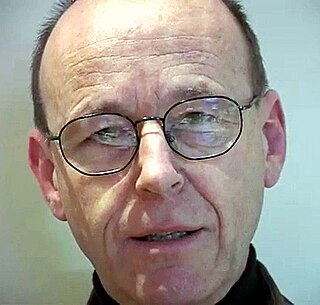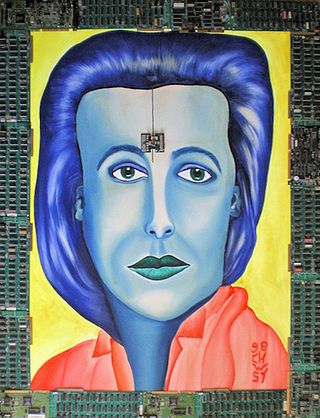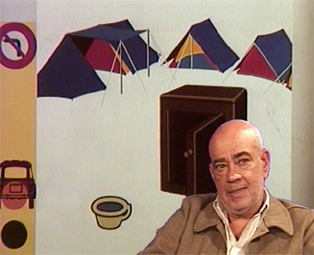Biography
Born August 16, 1943, in the Kingdom of Yugoslavia, Slobodan Pajic arrived in Paris in 1966 to study art history at the Sorbonne but was soon prompted to reorient himself to his own painting. He lives and works in Paris and has become a French citizen.
At the beginning of the 1970s, his abstract, geometrical art brought him success, but his passion for new media, as “new supports” for creation, soon won out. One of his early solo shows was the organization of space with laser light (Square root in a square) at the American Center in Paris in 1972. As soon as 1/2 inch video equipment was available, Pajic began to work on a series of short videos unlike anything done before: Exploiting the incapacity of the video scanning pattern to register isolated instants in their entirety, Pajic introduced abrupt changes by breaking reflective surfaces before the camera. (Dany Bloch)
The new Centre Georges Pompidou, in Paris, lent their post-production facilities for a compilation of these short films, Untitled 76: Destruction of Sound and Image, and provided some of the first showings. The enthusiastic reaction of the art world prompted the Musée National d’Art moderne to commission Pajic to produce the first artist’s video in their new, two-inch video studios. (Moisdon) Untitled 77 : Passage From Closed To Open Space, an abstract film in saturated color, continues to occupy a unique position in the history of video art.
In 1980, after a stay in New York, and a year of travel throughout Europe, Pajic settled into a new studio in Paris and began a series of installation pieces employing video screens and projections.
An Image Reflector installation consists of a mirrored video screen on the wall, before which is placed a video monitor with an abstract, repetitive film, accompanied by an electronic signal. As the spectator approaches the screen to see the film, his or her own reflection becomes part of the experience. (Nieto & Wilson-Pajic)
The Image Captors installations are typically composed of a large video screen on a wall, before which is placed a projector on a Plexiglas pedestal. The screen has been prepared with materials that capture the projection and restitute it in the dark. The image fades slowly, in the same way as an impression in short-term memory, and is replaced by another. (Nieto & Wilson-Pajic)
In 1996, the French National Museum of Modern Art commissioned an installation from the Image Captors series. The result, a large multi-screen installation Mémoires was presented in the anniversary exhibition Made In France. To the sound of a rocket launcher called Stalin’s Organ, images of war on 16 mm film decomposed motion and imprinted a prepared video screen, then abruptly disappeared, leaving the after-image to slowly fade in silence. On the other side of the room, 4 projections of fixed images of combats and refugees appeared in violent bursts and disappeared into the darkness. (Françoise Parfait) The piece is an altogether moving indictment of war and aggression.
In the early 80s, Pajic began a series of pictorial works exploiting the inability of laser light to pass through certain distortions of materials, by which he produced abstract, chance patterns and transformed them into arresting pictorial works (Graphismes). A series of installations followed, in which laser beams confront transparent and reflective forms to create abstract figures in space. (Official site)
At the beginning of the 90s, he constructed a high-frequency device and started work on a series of Electrophotograms. Based on the Tesla effect, the images are composed of minute points of light emanating from the material itself. The use of computer technology restores to the image all its brilliance and complexity. (Official site)
Since then, Pajic has continued to develop a body of work composed of installations, videos, films, graphic and photographic images. He has participated in numerous personal and collective exhibitions: Maastricht Museum, Evénement 03.23,03 in Montréal, the National Gallery of Canada in Ottawa, Musée National d'Art Moderne in Paris, Biennale de São Paulo, Video 79 in Rome, Biennale de Paris, Serpentine Gallery in London, Vor-Film Video in Munich. The Kitchen in New York, The Bay Area Video Coalition in San Francisco, the first video retrospective at the Long Beach Muséum of Art, Moderna Museet in Stockholm....

Pierre Bismuth is a French artist and filmmaker based in Brussels. His practice can be placed in the tradition of conceptual art and appropriation art. His work uses a variety of media and materials, including painting, sculpture, collage, video, architecture, performance, music, and film. He is best known for being among the authors of the story for Eternal Sunshine of the Spotless Mind (2004), for which he won the Academy Award for Best Original Screenplay alongside Michel Gondry and Charlie Kaufman. Bismuth made his directorial debut with the 2016 feature film Where is Rocky II?.
Alain Jacquet was a French artist representative of the Nouvelle Figuration movement that was linked to the American Pop Art movement. Jacquet lived in New York and Paris and taught at the École Nationale Supérieure des Arts Décoratifs. He was married (1992) to Sophie Matisse, great-granddaughter of the French Fauvist artist Henri Matisse. They had one daughter, Gaïa Jacquet-Matisse. Jacquet's art is displayed in the Museum of Modern Art in New York, and the Centre Pompidou, the Musée National d'Art Moderne, in Paris. Jacquet died of esophageal cancer in Manhattan.

Anthony McCall is a British-born New York based artist known for his ‘solid-light’ installations, a series that he began in 1973 with "Line Describing a Cone," in which a volumetric form composed of projected light slowly evolves in three-dimensional space.

Léopold Frédéric Léopoldowitsch Survage was a Russian-French painter of Finnish origin. Trained in Moscow, he identified with the Russian avant-garde before moving to Paris, where he shared a studio with Amedeo Modigliani and experimented with abstract films. He also gained commissions for Serge Diaghilev's Ballets Russes.

Dominique Gonzalez-Foerster is a French visual artist and educator. She is known for her work in video projection, photography, and art installations. She has worked in landscaping, design, and writing. "I always look for experimental processes. I like the fact that at the beginning I don't know how to do things and then, slowly, I start learning. Often exhibitions don't give me this learning possibility anymore."

Valérie Belin is a French art photographer. She lives and works in Paris.

Fabienne Verdier is a French painter who works in France after years of studies in China. She was the first non-Chinese woman to be awarded a post-graduate diploma in fine arts by the Sichuan Fine Arts Institute in Chongqing, China.

Catherine David is a French art historian, curator and museum director. David was the first woman and the first non-German speaker to curate documenta X in Kassel, Germany. David is currently deputy director of the National Museum of Modern Art at the Centre Georges Pompidou. She was born and lives in Paris.

Tania Mouraud is a contemporary French video artist and photographer.
Jan Kopp is a German visual artist. He has lived in France since 1991.

Raúl Cordero is a Cuban born conceptual painter. First known as part of the 90s generation in Cuba, when he started exhibiting his work mostly in Europe and the United States of America. Cordero represents through his work the "other Cuban art." Far from the standards of the Cuban Revolution art, and without falling into topics of other artists from in and out of the island, Cordero samples pretexts whimsically obtained from various referential origins and shows us his work as a result of recycling, of a revival, creating a new reality that refers more to art than to any other apparent content.

Najia Mehadji is an artist of Franco-Moroccan heritage who lives and works between Paris, France and Essaouira, Morocco.

Nancy Wilson-Pajic is an artist who uses narrative forms to make narrative, content-oriented artworks.

Carmen Lydia Đurić, known by her artist name Hessie, was a Cuban textile artist who lived in France from 1962 until her death. Her creative work was mainly focused on embroidery using fabrics, although she also used the technique of collage with waste materials.
Caroline Mesquita is a French sculptor. Mesquita was born in Brest, in Finistère, France. She has used film, and particularly stop motion animation, as a component of her work. Her work is included in the collections of the Musée National d'Art Moderne, Paris and the Fonds régional d'art contemporain.

Caoutchouc is a painting created circa 1909 by the French artist Francis Picabia. At the crossroads of Cubism and Fauvism, Caoutchouc is considered one of the first abstract works in Western painting. The painting is in the collection of Centre Pompidou, Musée National d'Art Moderne, in Paris.

Hervé Télémaque was a French painter of Haitian origin, associated with the surrealism and the narrative figuration movements. He lived and worked in Paris from 1961 on.

Sylvie Blocher is a French artist.
Martine Aballéa is a French-American artist born in 1950.

Jean Le Gac is a French conceptual artist, painter, pastelist, photographer using mixed media, frequently video or photography and text to document his investigations and sketched scenes. His poetic photographic interventions in which he is most often the main subject are accompanied either by typed text describing the underlying story in the artwork or handwritten notes in the art piece itself. Member of the Narrative art movement since the seventies, Le Gac ofttimes tells a story about an imaginary character that viewers can easily identify with the artist himself. He calls it a “metaphor for painting." Le Gac also uses the artist's book as a central part of his art practice. Le Gac is a Professor and lecturer at Institut des hautes études en arts plastiques.
















